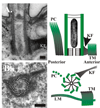Basal body assembly in ciliates: the power of numbers
- PMID: 19192246
- PMCID: PMC2743681
- DOI: 10.1111/j.1600-0854.2009.00885.x
Basal body assembly in ciliates: the power of numbers
Abstract
Centrioles perform the dual functions of organizing both centrosomes and cilia. The biogenesis of nascent centrioles is an essential cellular event that is tightly coupled to the cell cycle so that each cell contains only two or four centrioles at any given point in the cell cycle. The assembly of centrioles and their analogs, basal bodies, is well characterized at the ultrastructural level whereby structural modules are built into a functional organelle. Genetic studies in model organisms combined with proteomic, bioinformatic and identifying ciliary disease gene orthologs have revealed a wealth of molecules requiring further analysis to determine their roles in centriole duplication, assembly and function. Nonetheless, at this stage, our understanding of how molecular components interact to build new centrioles and basal bodies is limited. The ciliates, Tetrahymena and Paramecium, historically have been the subject of cytological and genetic study of basal bodies. Recent advances in the ciliate genetic and molecular toolkit have placed these model organisms in a favorable position to study the molecular mechanisms of centriole and basal body assembly.
Figures




Similar articles
-
The evolutionary conserved proteins CEP90, FOPNL, and OFD1 recruit centriolar distal appendage proteins to initiate their assembly.PLoS Biol. 2022 Sep 7;20(9):e3001782. doi: 10.1371/journal.pbio.3001782. eCollection 2022 Sep. PLoS Biol. 2022. PMID: 36070319 Free PMC article.
-
Polarities of the centriolar structure: morphogenetic consequences.Biol Cell. 1999 May-Jun;91(4-5):367-78. Biol Cell. 1999. PMID: 11419478 Review.
-
The Rise of the Cartwheel: Seeding the Centriole Organelle.Bioessays. 2018 Apr;40(4):e1700241. doi: 10.1002/bies.201700241. Epub 2018 Mar 6. Bioessays. 2018. PMID: 29508910 Review.
-
Basal body duplication in Paramecium: the key role of Bld10 in assembly and stability of the cartwheel.Cytoskeleton (Hoboken). 2010 Mar;67(3):161-71. doi: 10.1002/cm.20433. Cytoskeleton (Hoboken). 2010. PMID: 20217679
-
Centrin deficiency in Paramecium affects the geometry of basal-body duplication.Curr Biol. 2005 Dec 6;15(23):2097-106. doi: 10.1016/j.cub.2005.11.038. Curr Biol. 2005. PMID: 16332534
Cited by
-
Centriole assembly and the role of Mps1: defensible or dispensable?Cell Div. 2011 Apr 14;6:9. doi: 10.1186/1747-1028-6-9. Cell Div. 2011. PMID: 21492451 Free PMC article.
-
BBS4 is required for intraflagellar transport coordination and basal body number in mammalian olfactory cilia.J Cell Sci. 2019 Feb 15;132(5):jcs222331. doi: 10.1242/jcs.222331. J Cell Sci. 2019. PMID: 30665891 Free PMC article.
-
Cryo-electron tomography and 3-D analysis of the intact flagellum in Trypanosoma brucei.J Struct Biol. 2012 May;178(2):189-98. doi: 10.1016/j.jsb.2012.01.009. Epub 2012 Jan 25. J Struct Biol. 2012. PMID: 22285651 Free PMC article.
-
Cell cycle progression by the repression of primary cilia formation in proliferating cells.Cell Mol Life Sci. 2013 Oct;70(20):3893-905. doi: 10.1007/s00018-013-1302-8. Epub 2013 Mar 9. Cell Mol Life Sci. 2013. PMID: 23475109 Free PMC article. Review.
-
Tetrahymena Poc5 is a transient basal body component that is important for basal body maturation.J Cell Sci. 2020 Jun 4;133(11):jcs240838. doi: 10.1242/jcs.240838. J Cell Sci. 2020. PMID: 32350068 Free PMC article.
References
-
- Boveri T. Germany: Jena; 1914. Zur frage der entstehung maligner tumoren.
-
- Wilson E. 3rd ed. New York: Macmillan; 1925. The Cell in Development and Heredity.
-
- Bornens M, Azimzadeh J. Origin and evolution of the centrosome. Advances in experimental medicine and biology. 2007;607:119–129. - PubMed
-
- Basto R, Lau J, Vinogradova T, Gardiol A, Woods CG, Khodjakov A, Raff JW. Flies without centrioles. Cell. 2006;125(7):1375–1386. - PubMed
-
- Marshall WF, Nonaka S. Cilia: tuning in to the cell's antenna. Curr Biol. 2006;16(15):R604–R614. - PubMed
Publication types
MeSH terms
Grants and funding
LinkOut - more resources
Full Text Sources

